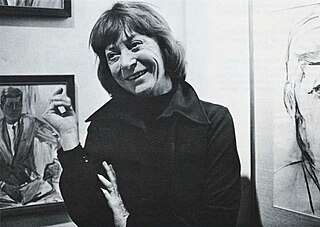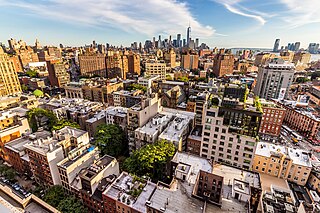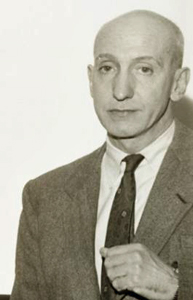Related Research Articles
Abstract Expressionism in the United States emerged as a distinct art movement in the immediate aftermath of World War II and gained mainstream acceptance in the 1950s, a shift from the American social realism of the 1930s influenced by the Great Depression and Mexican muralists. The term was first applied to American art in 1946 by the art critic Robert Coates. Key figures in the New York School, which was the epicenter of this movement, included such artists as Jackson Pollock, Franz Kline, Mark Rothko, Norman Lewis, Willem de Kooning and Theodoros Stamos among others.
Action painting, sometimes called "gestural abstraction", is a style of painting in which paint is spontaneously dribbled, splashed or smeared onto the canvas, rather than being carefully applied. The resulting work often emphasizes the physical act of painting itself as an essential aspect of the finished work or concern of its artist.

Willem de Kooning was a Dutch-American abstract expressionist artist. He was born in Rotterdam and moved to the United States in 1926, becoming an American citizen in 1962. In 1943, he married painter Elaine Fried.

Franz Kline was an American painter. He is associated with the Abstract Expressionist movement of the 1940s and 1950s. Kline, along with other action painters like Jackson Pollock, Willem de Kooning, Robert Motherwell, John Ferren, and Lee Krasner, as well as local poets, dancers, and musicians came to be known as the informal group, the New York School. Although he explored the same innovations to painting as the other artists in this group, Kline's work is distinct in itself and has been revered since the 1950s.

Elaine Marie Catherine de Kooning was an Abstract Expressionist and Figurative Expressionist painter in the post-World War II era. She wrote extensively on the art of the period and was an editorial associate for Art News magazine.

Robert Henry De Niro, better known as Robert De Niro Sr., was an American abstract expressionist painter and the father of actor Robert De Niro.

Leo Castelli was an Italian-American art dealer who originated the contemporary art gallery system. His gallery showcased contemporary art for five decades. Among the movements which Castelli showed were Surrealism, Abstract Expressionism, Neo-Dada, Pop Art, Op Art, Color field painting, Hard-edge painting, Lyrical Abstraction, Minimal Art, Conceptual Art, and Neo-expressionism.
Sidney Janis was a wealthy clothing manufacturer and art collector who opened an art gallery in New York in 1948. His gallery quickly gained prominence, for he not only exhibited work by the Abstract Expressionists, but also European artists such as Pierre Bonnard, Paul Klee, Joan Miró, and Piet Mondrian. As the critic Clement Greenberg explained in a 1958 tribute to Janis, the dealer's exhibition practices had helped to establish the legitimacy of the Americans, for his policy "not only implied, it declared, that Jackson Pollock, Willem de Kooning, Franz Kline, Phillip Guston, Mark Rothko, and Robert Motherwell were to be judged by the same standards as Matisse and Picasso, without condescension, without making allowances." Greenberg observed that in the late 1940s "the real issue was whether ambitious artists could live in this country by what they did ambitiously. Sidney Janis helped as much as anyone to see that it was decided affirmatively."

The 9th Street Art Exhibition of Paintings and Sculpture is the official title artist Franz Kline hand-lettered onto the poster he designed for the Ninth Street Show. Now considered historic, the artist-led exhibition marked the formal debut of Abstract Expressionism, and the first American art movement with international influence. The School of Paris, long the headquarters of the global art market, typically launched new movements, so there was both financial and cultural fall-out when all the excitement was suddenly emanating from New York. The postwar New York avant-garde, artists like Willem de Kooning and Jackson Pollock, would soon become "art stars," commanding large sums and international attention. The Ninth Street Show marked their "stepping-out," and that of nearly 75 other artists, including Harry Jackson, Helen Frankenthaler, Michael Goldberg, Joan Mitchell, Grace Hartigan, Robert De Niro Sr., John Ferren, Philip Guston, Elaine de Kooning, Lee Krasner, Franz Kline, Ad Reinhardt, David Smith, Milton Resnick, Joop Sanders, Robert Motherwell, Barnett Newman, and many others who were then mostly unknown to an art establishment that ignored experimental art without a ready market.
James Rosati was an American abstract sculptor. He is best known for creating an outdoor sculpture in New York: a stainless steel Ideogram.

Knox Martin was an American painter, sculptor, and muralist.
Elias Goldberg was an American painter.
The 10th Street galleries was a collective term for the co-operative galleries that operated mainly in the East Village on the east side of Manhattan, in New York City in the 1950s and 1960s. The galleries were artist run and generally operated on very low budgets, often without any staff. Some artists became members of more than one gallery. The 10th Street galleries were an avant-garde alternative to the Madison Avenue and 57th Street galleries that were both conservative and highly selective.
The Stable Gallery, originally located on West 58th Street in New York City, was founded in 1953 by Eleanor Ward. The Stable Gallery hosted early solo New York exhibitions for artists including Marisol Escobar, Robert Indiana and Andy Warhol.

Joop Sanders was a Dutch-American painter, educator, and founding member of the American Abstract Expressionist group. He was the youngest member of the first generation of the New York School.
Samuel M. Kootz was a New York City art dealer and author whose Kootz Gallery was one of the first to champion Abstract Expressionist Art.

George McNeil was an American abstract expressionist painter.
Annalyn Swan is an American writer and biographer who has written extensively about the arts. With her husband, art critic Mark Stevens, she is the author of de Kooning: An American Master (2004), a biography of Dutch-American artist Willem de Kooning, which was awarded the 2005 Pulitzer Prize for Biography or Autobiography. De Kooning also won the National Book Critics Circle prize for biography and the Los Angeles Times biography award, and was named one of the 10 best books of 2005 by The New York Times. In her review in The New York Times, Janet Maslin wrote: "The elusiveness of its subject makes the achievements of de Kooning: An American Master that much more dazzling."
Mark Stevens is an American writer who was co-awarded the 2005 Pulitzer Prize for Biography or Autobiography with Annalyn Swan for De Kooning: An American Master. His book with Swan also received the National Book Critics Circle Award for Biography in 2004 and a Los Angeles Times Book Prize in 2005. During his writing career, Stevens was an art critic for Newsweek, The New Republic and New York between the 1970s to 2000s. Other publications by Stevens include a 1981 work on Richard Diebenkorn's art and a 1984 book called Summer of the City.
The Club has been called "a schoolhouse of sorts ... as well as a theater, gallery space, and a dancehall...." Created by abstract expressionist sculptor Philip Pavia, The Club grew out of the informal gatherings among dozens of painters and sculptors who all had art studios in Lower Manhattan between 8th and 12th streets and First and Sixth Avenues during the late 1940s and early 1950s. Membership included many of New York's most important mid-century artists and thinkers, predominantly painters and sculptors like Willem de Kooning, Franz Kline, Isamu Noguchi, John Ferren, and Robert Motherwell, as well as nearly all the artists later called the New York School. But other celebrated artists, cultural figures and major 20th-century thinkers attended meetings, including philosopher Joseph Campbell, composer John Cage and political theorist Hannah Arendt. Structured to facilitate the growth and dissemination of ideas about art by artists for artists, especially abstract expressionist art, The Club lent New York's art scene the vitality and international influence Paris had long monopolized, and U.S. artists had long craved.
References
- ↑ Mark Stevens, Annalyn Swan, "De Kooning : an American master," (New York: A.A. Knopf, 2004), p. 225
- ↑ Lambert, Bruce (March 18, 1993). "Charles Egan, 81; Art Gallery Owner Helped de Kooning". New York Times. Retrieved October 16, 2007.
- ↑ http://www.sothebys.com/app/live/lot/LotDetail.jsp?lot_id=159592539%5B%5D
- ↑ "About Art and Artists; Knox Martin Impresses in First One-Man Show". The New York Times. September 16, 1954. Retrieved April 28, 2010.
- ↑ The Egan Gallery years retrieved October 10, 2008 Archived July 9, 2008, at the Wayback Machine
- ↑ review by Knox Martin, retrieved October 10, 2008